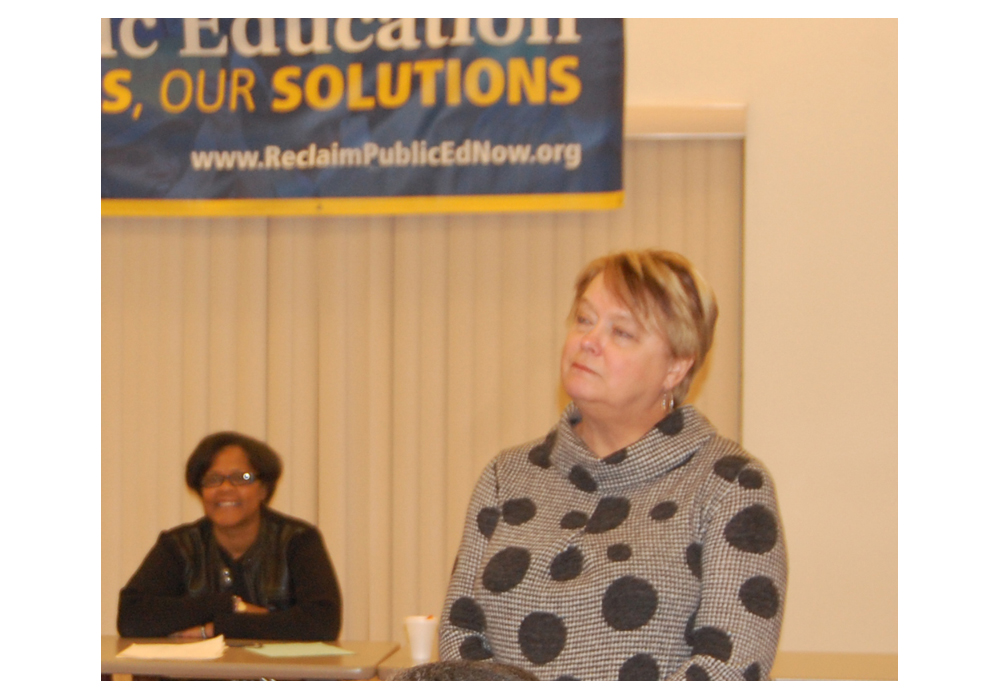
From 2017: Dr. Peggy Hinckley at a Gary Teachers Union community forum
6-year timeline to Gary schools financial stability
Contributed By:The 411 News
Balancing the budget in 2019 is first goal for emergency management team
What to do when you owe $18 million more than you had to spend in 2017? That’s the first hole the emergency management team Gary Schools Recovery LLC (Dr. Peggy Hinckley and MGT Consulting Group) is working to close for the Gary school district.
Add to that, the school district has a $100 million-plus debt – an accumulation of past years of deficits.
The management team previewed its plan to close the deficit and start paying down the debt at a meeting with the school district’s Fiscal Management Board last week and presented the full plan to the Distressed Unit Appeal Board in Indianapolis on Wednesday, January 31.
The emergency management team was required to bring its findings to the DUAB 6 months after it became the state’s partner in the takeover of the school district. The team began its management of the Gary Community School Corporation August 1, 2017.
Much of that annual deficit is being paid by the state.
MGT financial analyst Eric Parish said the plan will close the $18 million deficit in 2019, pay down the debt, and bring in $174 million in benefits and revenues to the district by 2024.
It included a list of nearly 30 initiatives that could return the district to financial stability. “For some initiatives, we’ll have to spend money to make or save money,” Parish said. “Some will work, some won’t and we will have to update the plan every 6 months. There may be obstacles that present themselves that we don’t know today, but we’ll have multiple pathways to get to fiscal stability.”
Initiatives like asking the state to suspend repayments the district is making for borrowings from the Common School Fund. That will allow some of the district’s nearly $4 million in yearly loan repayments to be used for other purposes.
Better accounting practices, better management and oversight of federal funds could bring in about $500,000 a year.
Instead of requesting loans from the state, ask for grants that won’t have to be repaid.
Refinance loans to reduce installment repayment amounts. That will lengthen the termination date of the loan, but savings from the reduced repayments can be used elsewhere.
Reduce costs by closing some schools. Dr. Hinckley has proposed closing either West Side or Wirt-Emerson at the end of the school year. Now, Roosevelt High is in the mix.
“The three high schools have a capacity for 7,000 students; currently, they have less than 2,000,” Parish said, “and we’re considering putting Roosevelt in a better building.” Closing a high school would reduce costs by $900,000. Moving the school service center at 19th and Polk into another building is also being considered.
Go to voters with another property tax referendum.
Initiatives to increase student enrollment between 200 and 300 students in 2018 and 2019 will bring in more revenues.
Parish described “organically growing enrollment” with students who have never attended Gary schools but are attracted to district programs.
A partnership with Ivy Tech Community College is expected to attract more students. IVT is closing its welding and building trades programs, transferring them to the Gary Career Center. “Some of our school district programs will be moved to IVT that they don’t have,” Dr. Hinckley said, “and we’ll be recruiting from neighboring school corporations that used to send students to the career center, but now go to Hammond.”
Under every dollar counts initiatives, the school district could get reimbursed for signing up students for Medicaid. Parish said, “The district does not have a high participation or sign-up rate for Medicaid.” Other of those initiatives: Using community crowd funding for sports programs and school activities, and becoming a charter school authorizer.
It’s not about turning any of Gary corporation schools into charters or initiating new charters, Parish said. Authorizers retain 3% of each charter’s state funding as payment for monitoring the charter school. Indiana has 3 types of authorizers -- universities, city mayors, and school districts.
The initiative targets existing Gary charter schools that Parish believe would join with the Gary schools corporation. “There’s economy of scale, access to infrastructure, a sense of we’re fighting over the same students so let’s join forces, and they see what MGT is doing in Gary is the right path to be on.”
The DUAB had questions for the emergency management team at the Fiscal Management Board meeting, where DUAB executive director Courtney Schaafsma participated by phone conference. She had asked the team to consider the fiscal impacts of changing the configurations of the district. What would the district look like as a K-8 operation only and as a K-6 operation? What would be the impact of changing district borders?
“A K-8 operation would save about $2.4 million annually by eliminating the high schools; a K-6 operation would save about $2.6 million,” Parish said.
Schaafsma told the board, “There are no preconceived notions by DUAB regarding the 2 options; it was just looking at the district’s enrollment when these 2 options came to mind. DUAB is not in any place where decisions will be made.”
Regarding changing district boundaries, Parish said, “We’re having trouble building models because there are so many moving parts, but we’ll work on it.”
 File Photo from 2017: Dr. Peggy Hinckley at a Gary Teachers Union community forum
File Photo from 2017: Dr. Peggy Hinckley at a Gary Teachers Union community forum
Story Posted:02/03/2018
|